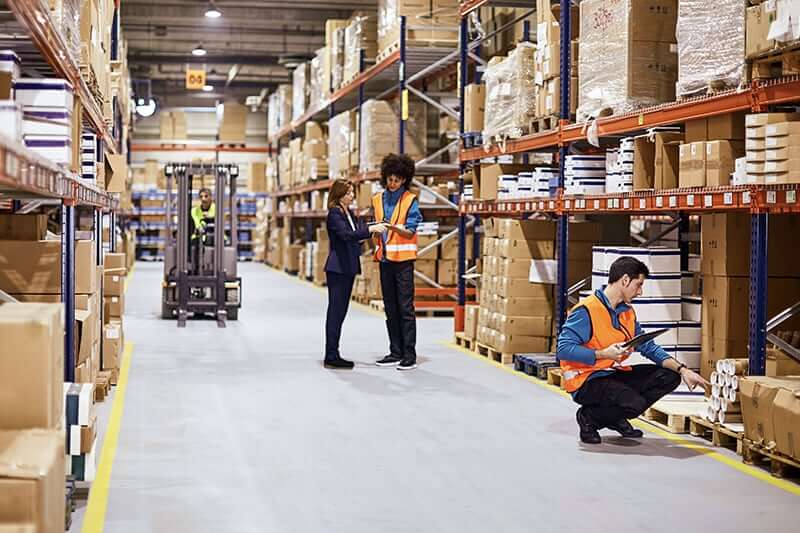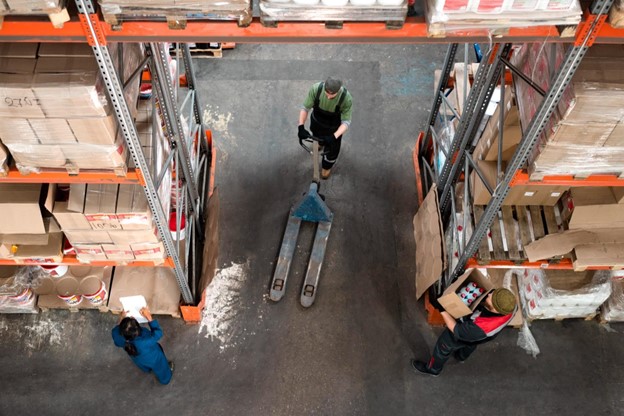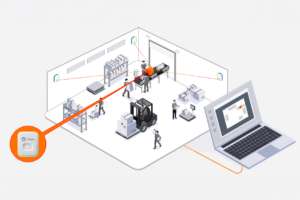What is Bluetooth Low Energy (BLE)?
Bluetooth Low Energy (BLE) is a wireless communication technology introduced in 2011 as part of the Bluetooth 4.0 standard. Designed for short-range, low-power data transmission, BLE allows devices to communicate efficiently without draining battery life. It uses the same 2.4 GHz frequency band as classic Bluetooth, but with key differences that make it especially suitable for real-time location tracking and other low-energy applications.
BLE is now widely used in industries such as healthcare, manufacturing, retail, and logistics. At Litum, we develop RTLS (Real-Time Location Systems) that incorporate both BLE and UWB (Ultra-Wideband) to provide precise, efficient, and scalable tracking solutions tailored to different environments and operational needs.
How BLE Works
To understand how BLE works, it helps to break down the technology into its core functions. BLE operates using 40 narrow 2-MHz channels within the 2.4 GHz ISM band. It uses Gaussian frequency shift keying (GFSK) to transmit data with reduced interference. Unlike classic Bluetooth, BLE is built for low-duty cycles: it spends most of its time in sleep mode and only transmits data in short bursts when needed.
BLE devices use advertising packets to broadcast their presence. These packets are sent over three primary advertising channels to minimize interference. Nearby devices scan for these packets by opening periodic “scan windows.” If a packet is detected and a connection is established, the devices exchange data efficiently before returning to low-power mode. This approach allows BLE devices to operate for months or even years on small batteries, making the technology ideal for scalable deployments in tracking and monitoring systems.
BLE vs. Classic Bluetooth
While BLE and Bluetooth share similar security protocols and operate on the same frequency, they are designed for different use cases.
- Power Efficiency: BLE consumes significantly less power by remaining in sleep mode until a connection is required. This allows BLE tags and sensors to operate for years on a single coin cell battery.
- Range and Throughput: Classic Bluetooth offers greater range and higher throughput (up to 2 Mbps), making it suitable for continuous data transmission. BLE, by contrast, transmits smaller data packets at 100–250 Kbps, which is sufficient for location tracking, alerts, and basic sensor data.
- Connection Speed: BLE connects in just a few milliseconds, compared to about 100 milliseconds for Bluetooth.
- Scalability: BLE devices can connect with more peripherals at once, depending on memory and implementation. This makes BLE more effective for environments with many tracked assets.
- Cost: BLE devices tend to have simpler hardware and smaller batteries, resulting in lower cost and easier deployment across large facilities.
Litum leverages BLE in real-time tracking applications where long battery life, fast connection, and scalability are essential.
BLE Beacons and How They Work
BLE beacons are small devices that periodically broadcast signals containing identifying information, typically a universally unique identifier (UUID). These signals are picked up by compatible receivers, such as smartphones or gateways, that use the data to trigger actions or determine proximity.
The UUID helps distinguish one beacon from another. BLE beacon protocols include iBeacon (used by Apple), AltBeacon (open source), and Eddystone (developed by Google). Some beacons can also transmit additional data such as battery level or temperature.
Did you know?
UUIDs are designed with 128 bits of data, allowing for an enormous number of unique combinations. That’s why the chance of two being the same is almost zero. To put it into perspective: if you created 1 billion UUIDs every second, it would take you over 100 trillion years to run out of unique ones.
Interaction with BLE beacons usually requires compatible software on the receiving device. This ensures that signals are only acted upon when appropriate, enhancing privacy and control.
In Litum’s RTLS deployments, BLE beacons play a key role in enabling indoor tracking, zone-based alerts, and guided navigation in facilities.

How Bluetooth Positioning Works
BLE-based positioning works by measuring the signal strength (RSSI) between beacons and receiving devices. As signal strength varies with distance, systems can estimate how far a device is from a beacon and triangulate its position using multiple beacons.
For higher accuracy, techniques such as Angle of Arrival (AoA) and Angle of Departure (AoD) can be used. These require multiple antennas or synchronized transmitters to determine the direction of signals.
Litum uses BLE positioning for applications where sub-meter accuracy is not critical but power efficiency and cost-effectiveness are. For use cases that demand higher precision, such as collision warning or staff duress, we typically use UWB.
BLE vs. UWB
While BLE is designed for low-power, cost-efficient tracking, Ultra-Wideband (UWB) offers much higher precision and lower latency. UWB uses time-of-flight (ToF) measurements to determine distance with sub-meter accuracy and very low latency.
BLE is suitable for many indoor positioning needs, especially in settings like retail, logistics, and healthcare asset tracking. UWB is preferred when exact positioning is required, such as in staff safety systems, forklift collision warning, or secure access control.
Litum provides both BLE and UWB-driven RTLS solutions to match the specific requirements of each deployment.
BLE Use Cases by Application
BLE supports a wide range of indoor applications where real-time visibility, automation, and contextual interaction are needed.
- People and Asset Tracking: BLE is widely used to track the locations of people, equipment, and goods within indoor environments. It improves operational visibility and safety, especially in warehouses and healthcare facilities.
- Navigation and Wayfinding: BLE can guide people through complex environments like hospitals, airports, or factories. When paired with mobile apps, beacons can help users reach their destination efficiently.
- Point of Interest and Item Finding: BLE beacons can trigger contextual content or help locate specific items in a facility, such as tools, wheelchairs, or storage bins.
- Information Sharing: BLE can broadcast URLs or trigger app notifications to deliver relevant content based on proximity. This is common in museums, exhibitions, or retail stores.
BLE Use Cases by Industry
Various sectors rely on BLE technology to improve operations, safety, and user experience through low-power, location-based services.
- Healthcare: BLE supports patient flow, asset tracking, and staff visibility while maintaining low infrastructure costs.
- Manufacturing: BLE enhances visibility across production lines and helps track assets and personnel in real time.
- Education: Schools and universities use BLE for automated attendance, access control, and location-based messaging.
- Retail and Advertising: BLE enables personalized promotions and tracks in-store behavior to optimize layout and marketing.
- Travel and Entertainment: BLE improves guest experiences through guided navigation, digital check-ins, and context-aware content delivery.
- Security: BLE helps secure access to restricted areas and monitors environmental conditions such as temperature and humidity.
Conclusion
Bluetooth Low Energy is a versatile technology that powers a wide range of real-time tracking and communication solutions. Its low power requirements, flexible deployment options, and compatibility with most modern devices make it a practical choice for scalable location-based services.
At Litum, we combine BLE and UWB technologies to deliver reliable, accurate, and efficient RTLS solutions across industries. Whether the priority is battery life, cost, or high-precision, we build systems that match the need.




